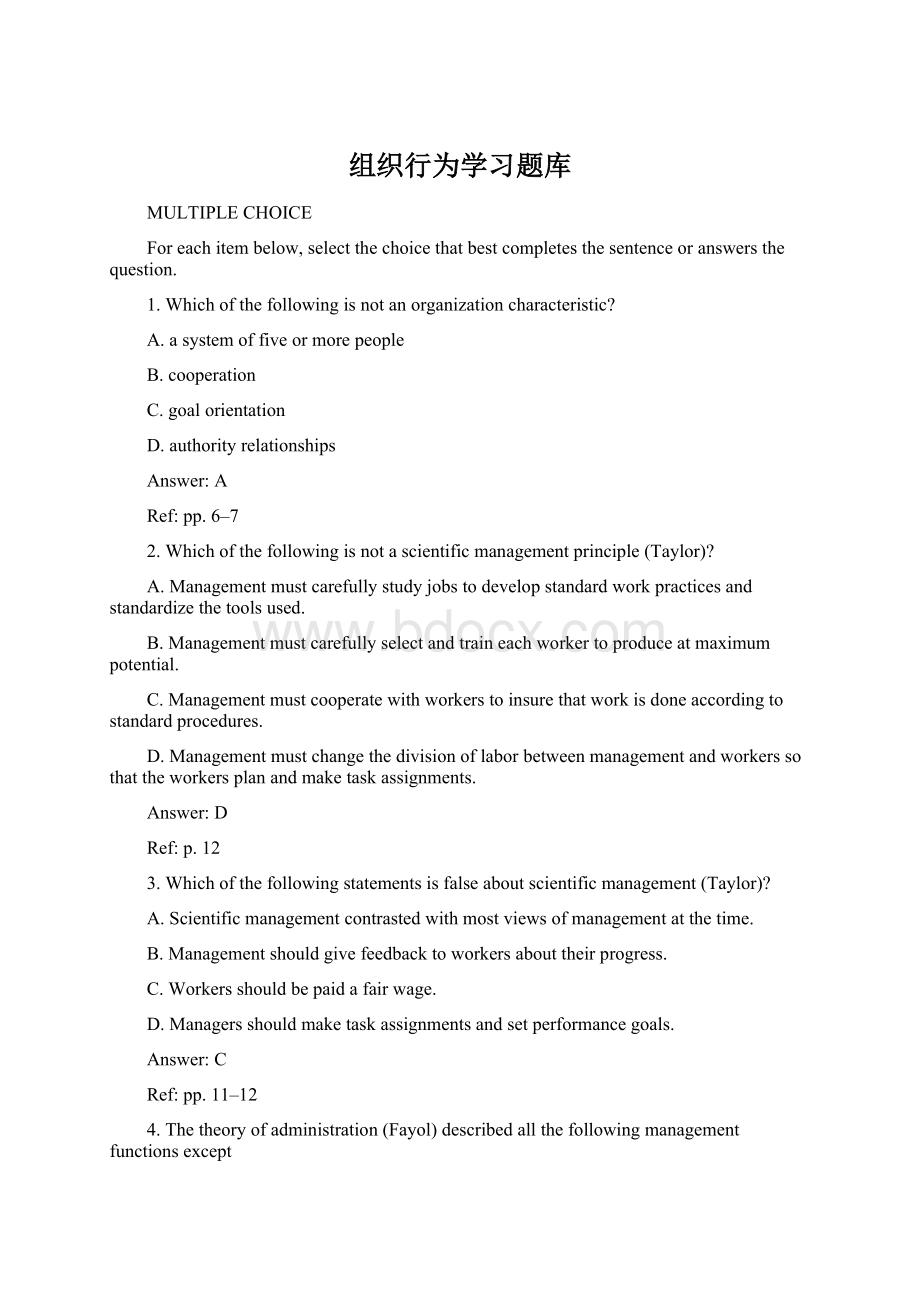组织行为学习题库.docx
《组织行为学习题库.docx》由会员分享,可在线阅读,更多相关《组织行为学习题库.docx(135页珍藏版)》请在冰豆网上搜索。

组织行为学习题库
MULTIPLECHOICE
Foreachitembelow,selectthechoicethatbestcompletesthesentenceoranswersthequestion.
1.Whichofthefollowingisnotanorganizationcharacteristic?
A.asystemoffiveormorepeople
B.cooperation
C.goalorientation
D.authorityrelationships
Answer:
A
Ref:
pp.6–7
2.Whichofthefollowingisnotascientificmanagementprinciple(Taylor)?
A.Managementmustcarefullystudyjobstodevelopstandardworkpracticesandstandardizethetoolsused.
B.Managementmustcarefullyselectandtraineachworkertoproduceatmaximumpotential.
C.Managementmustcooperatewithworkerstoinsurethatworkisdoneaccordingtostandardprocedures.
D.Managementmustchangethedivisionoflaborbetweenmanagementandworkerssothattheworkersplanandmaketaskassignments.
Answer:
D
Ref:
p.12
3.Whichofthefollowingstatementsisfalseaboutscientificmanagement(Taylor)?
A.Scientificmanagementcontrastedwithmostviewsofmanagementatthetime.
B.Managementshouldgivefeedbacktoworkersabouttheirprogress.
C.Workersshouldbepaidafairwage.
D.Managersshouldmaketaskassignmentsandsetperformancegoals.
Answer:
C
Ref:
pp.11–12
4.Thetheoryofadministration(Fayol)describedallthefollowingmanagementfunctionsexcept
A.planning.
B.organizing.
C.bureaucracy.
D.control.
Answer:
C
Ref:
p.12
5.Whichofthefollowingisamongthebasicmanagementideasinthetheoryofadministration(Fayol)?
A.divisionofwork
B.authorityandresponsibility
C.unityofcommand
D.Allanswersnoteabasicmanagementideainthetheoryofadministration.
Answer:
D
Ref:
pp.12–13
6.Whichofthefollowingisnotamanagementfunctionaccordingtothetheoryofadministration(Fayol)?
A.planning
B.organizing
C.control
D.integrating.
Answer:
D
Ref:
pp.12–13
7.Theviewthatapersonshouldreceiveordersfromonlyonesupervisoristheprincipleof
A.centralization.
B.unityofcommand.
C.authorityandresponsibility.
D.unityofdirection.
Answer:
B
Ref:
pp.12–13
8.Theviewthatthereshouldbeasinglegoalforadepartmentorworkunitistheprincipleof
A.centralization.
B.unityofcommand.
C.authorityandresponsibility.
D.unityofdirection.
Answer:
D
Ref:
pp.12–13
9.Whichofthefollowingisafeatureofbureaucracy?
A.impersonality
B.specificallydefinedfunctions
C.writtenrulesandprocedures
D.Allanswersarecorrect.
Answer:
D
Ref:
pp.13–14
10.Thetextbookdescribedthreewaysofmanagingconflict(Follett).Whichofthefollowingarethethreeconflictmanagementmethods?
A.divisionoflabor,legalauthority,charisma
B.dominance,compromise,differentiation
C.delegationofauthority,integration,dominance
D.dominance,integration,compromise
Answer:
D
Ref:
pp.14–15
11.Acreativesuggestion(Follett)formanagingconflictis
A.dominance.
B.integrationofdesires.
C.compromise.
D.accommodative.
Answer:
B
Ref:
pp.14–15
12.Anearlyviewofleadership(Follett)proposedthatithadwhichofthefollowingfeatures?
A.Leadershavevisionsofthefuture.
B.Leadersknowthetechnicalpartsoftheirjobs.
C.Leadersdeveloptheirsubordinatestobecomeleaders.
D.Allanswersarecorrect.
Answer:
D
Ref:
pp.14–15
13.WhichofthefollowingareTheoryXassumptions?
A.Theaveragepersonwantssecurity,haslittleambition,andavoidsresponsibility.
B.Theaveragepersondislikesworkingandwillavoiditifpossible.
C.Becausepeopledislikeworking,theymustbetightlycontrolledandpressuredtogetthemtoworktowardorganizationalgoals.
D.Allanswersarecorrect.
Answer:
D
Ref:
pp.18–19
14.WhichofthefollowingisnotaTheoryYassumption?
A.Ifapersoniscommittedtoasetofgoals,heorshewillworktowardthemwithoutexternalcontrol.
B.Theaveragepersoncanlearntoacceptresponsibility.Lackofambitionisnotabasichumancharacteristic.
C.Modernorganizationsfullyusetheirworkers’potentialities.
D.Creativity,ingenuity,andimaginationarehumancharacteristicsthatarewidelydispersedinthepopulation.
Answer:
C
Ref:
pp.18–19
15.Organizationalcultureincludeswhichofthefollowingcharacteristics?
A.Itisacomplexaspectoforganizationsthatstronglyaffectsorganizationmembers.
B.Itincludesvalues,norms,rites,heroes,andscoundrelsintheorganization’shistory.
C.Akeyaspectoforganizationalcultureisvaluesharingandstructuringofexperiencesintheorganization.
D.Eachanswerlistsanorganizationalculturecharacteristics.
Answer:
D
Ref:
p.72
Anemployeeonlylistenstoasupervisor’spositivefeedbackandnotthenegativefeedback.Thisisanexampleof
A.perceptualset.
B.perceptualdefense.
C.stereotyping.
D.detectionthreshold.
Answer:
B
Ref.:
pp.100–101
Whichofthefollowingfactorsdoesnotaffectone’sself-concept?
A.self-consciousness
B.recallofpastevents
C.observationsofownbehavior
D.socialcontext
Answer:
A
Ref.:
pp.101–102
Whichofthefollowingisnotpartofself-perception?
A.self-concept
B.self-presentation
C.self-consciousness
D.self-esteem
Answer:
C
Ref.:
pp.101–102
Whichofthefollowingstatementsisfalse?
A.People’sself-awarenesscanincludeeitheraprivateorapublicself-consciousness.
B.Peopleusuallyunderestimatetheirroleinpastevents.
C.Peoplelearnaboutthemselvesbycomparingtootherpeoplewithsimilarqualities.
D.Self-esteemholdsthepositiveandnegativeevaluationswehaveofourselves.
Answer:
B
Ref.:
pp.101–102
Thenegativeandpositivejudgmentspeoplehaveaboutthemselvesreferto
A.self-concept.
B.self-presentation.
C.stereotype.
D.self-esteem.
Answer:
D
Ref.:
pp.101–102
Whichofthefollowinginformationsourcesdopeopleusewhenformingimpressionsofanotherperson?
A.theperson
B.thesituation
C.observedbehavioroftheperson
D.Peopleusewhateachanswerdescribeswhenformingimpressionsofanotherperson.
Answer:
D
Ref.:
pp.102–104
Whichofthefollowingisnotinformationusedbyperceiverstoformattributions?
A.situationalinformation
B.distinctivenessinformation
C.consensusinformation
D.consistencyinformation
Answer:
A
Ref.:
pp.102–104
Amanagerhasnoticedthatasubordinateisnotfriendlytocoworkersandisnotfriendlyinsocialsituationsoutsidework.Themanagerisusing______________informationwhenexplainingthecauseoftheunfriendliness.
A.consistency
B.consensus
C.distinctiveness
D.personal
Answer:
C
Ref.:
pp.102–104
Whichofthefollowingisnotpartofanattitude?
A.behavioralintentions
B.behaviors
C.cognition
D.affect
Answer:
B
Ref.:
p.105
Aperson’sfeelingsoflikeordislikeaboutacertainobjectreflectthe_______________partofanattitude.
A.cognitive
B.behavioral
C.affective
D.behavioralintentions
Answer:
C
Ref.:
p.105
Amanagerhasapositiveattitudeaboutanemployee.Themanagerwilllikelygivethisemployeedesiredworkassignmentsandaddedresponsibility.Thisreflectsthe______________partofthemanager’sattitude.
A.behavioralintentions
B.affective
C.cognitive
D.behavioral
Answer:
A
Ref.:
p.105
Whichofthefollowingisnotawayattitudescanchange?
A.persuasivecommunication
B.dissatisfactionwiththeattitudeobject
C.socialinfluence
D.cognitivedissonance
Answer:
B
Ref.:
pp.106–107
Anewemployeestronglyvalueshisgroupofcoworkerswhoroutinelytakelonglunches.Thisemployeebelievesthatworkersshouldonlytakethetimeallottedforlunch,butovertimehebeginstoaccepttheattitudeofhiscoworkerstowardlonglunches.Thisisanexampleofwhichsourceofattitudechange?
A.dissonance
B.persuasion
C.dissatisfaction
D.socialinfluence
Answer:
D
Ref.:
pp.106–107
Whichofthefollowingstatementsistrueaboutcognitivedissonance?
A.Apersoncanreducedissonancebychangingoneormorecognitions.
B.Ifapersonexperiencesdissonance,heorshefeelsaninternaltensionandtriestoreducethattension.
C.Multiplebeliefsaboutanattitudeobjectcanresultfrompersuasionorsocialinfluence.
D.Eachansweristrueaboutcognitivedissonance.
Answer:
D
Ref.:
pp.106–107
Aperson’spersonalitytypicallystabilizesbythetimethepersonreachesage
A.16.
B.23.
C.30.
D.35.
Answer:
C
Ref.:
p.107
Whichofthefollowingisnotamajorclassofpersonalitytheory?
A.cognitivetheory
B.learningtheory
C.ethologicaltheory
D.biologicaltheory
Answer:
C
Ref.:
pp.107–108
Theclassofpersonalitytheorythatviewsachildasneitherdrivenbyinstinctsnorshapedbytheenvironmentis
A.cognitivetheory.
B.biologicaltheory.
C.learningtheory.
D.ethologicaltheory.
Answer:
A
Ref.:
pp.107–108
Thepersonalitytheorythatsuggestspeoplelearnbyobservingothersis
A.operant-learningtheory.
B.biologicaltheory.
C.cognitivetheory.
D.social-learningtheory.
Answer:
D
Ref.:
pp.107–108
Thetheorythatsayspersonalityformsfrominheritedpersonalitycharacteristicsis
A.operant-learningtheory.
B.cognitivetheory.
C.biologicaltheory.
D.social-learningtheory.
Answer:
C
Ref.:
pp.107–108
Thepersonalitytheorythatsuggestspersonalityisformedbytheapplicationofreinforcerswhichdevelopbehaviorpatternsis
A.cognitivetheory.
B.operant-learningtheory.
C.social-learningtheory.
D.biologicaltheory.
Answer:
B
Ref.:
pp.107–108
Anadultisviewedaspolitebecauseasachildshewatchedotherchildrengetrewardedforsaying“please”and“thankyou,”andadoptedthesamebehaviors.Thisisanexampleofthe______________theoryofpersonality.
A.operant-learning
B.biological
C.cognitive
D.social-learning
Answer:
D
Ref.:
pp.107–108
Whichofthefollowingstatementsisnottrueabout